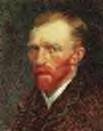
This blog site seems to be a more appropriate place for my Van Gogh article which by now was buried deep in the archives at billybelk.blogspot.com , so I decided to move it here...
A few years ago my wife, Linda, and I were browsing through a store, and I found prints of four paintings by Vincent van Gogh. Being a fan of Van Gogh, I attempted to talk Linda into allowing me to purchase the four prints. Unfortunately, my taste in home décor varies a bit from Linda’s, so she was not about to allow me to hang Van Gogh prints in our living room. I must say that my appreciation (or perhaps fascination) for Van Gogh transcends his artwork. Van Gogh’s life was/is an example of a great universal need known as “redemption”.
Vincent van Gogh was born in the town of Groot-Zundert, Holland, in 1853. Van Gogh was a brilliant artist, but unfortunately, he was mentally unstable. As an adult, Vincent moved to Paris hoping to find success as an artist. After spending two years with his brother, Theo, himself an art dealer in Paris, Vincent traveled to the city of Arles where he worked alongside painter, Paul Gauguin. However, the two artists often quarreled, and, in the aftermath of one very intense argument, Van Gogh, being as unstable as he was, cut off a portion of his ear and had it delivered to a prostitute. Realizing that his own instability had gotten out of hand, Vincent van Gogh committed himself to an asylum where he continued to work at his painting. During that difficult time Van Gogh continued to receive sympathetic encouragement from his brother. Nevertheless, Vincent van Gogh shot himself to death in 1890.
I was thinking about Vincent van Gogh earlier in the week when one of his paintings made headlines. It turns out that one of the paintings that Van Gogh created while in the asylum may bring well over 40 million dollars when it’s auctioned off this May. The painting is called: “L'Arlesienne, Madame Ginoux” and its subject is the person who was Van Gogh’s landlord at the time he cut off his ear.
There are two dimensions to Van Gogh’s story; one is the art and the other is the artist himself. Here is the irony between the two: The artwork seems to have found something that eluded the artist his entire life... redemption! After all, if something is worth 40 million dollars, it has become rather valuable to say the least. But as valuable as the artwork has become, is it really worth more than the artist or any human being for that matter? Consider Psalm 49, verses 7-8... Truly no man can ransom another, or give to God the price of his life, for the ransom of their life is costly and can never suffice.
Being a fan of his artwork, I’m glad that Van Gogh’s art continues to increase in value, but my heart breaks for the artist who never understood the value of his own life. Van Gogh’s story has reminded me again that people are far more valuable than the objects we seem to covet. May the hearts of all evangelical Christians break at the thought of redemption eluding our neighbors, and may such heartbreak stir us to action. And if we are ever tempted to question the value of man-kind, I would challenge us all to look again to the Cross and understand the price paid for the redemption that is ours in Christ alone.
1 comment:
Excellent post Billy. I like the idea of appreciating a person's art while not endorsing his or her worldview.
I am more of a sports fan than an art buff (hmm, a new blog maybe?), so I would make a comparison here that some will undoubtedly claim is a stretch. Pete Rose may very well be the Van Gogh of baseball. As a child, there was no one I enjoyed watching play more than "Charlie Hustle." I remember very well watching him break Ty Cobb's career hit record. But I have been appalled at how his life has spiraled recklessly since his gambling allegations first surfaced. As a ballplayer, I don't think I've ever seen a better one. But when I look at Pete, the man off the field, I see a life crying out for redemption, if he will only acknowledge that need. I pray that he finds it, lest he plunge to the depths that Van Gogh reached.
Post a Comment